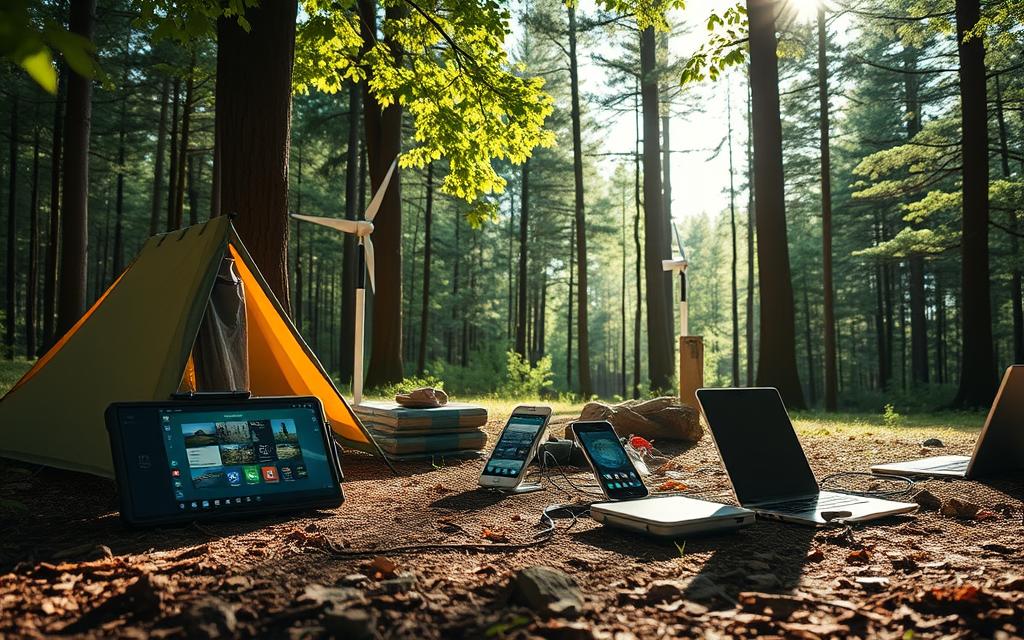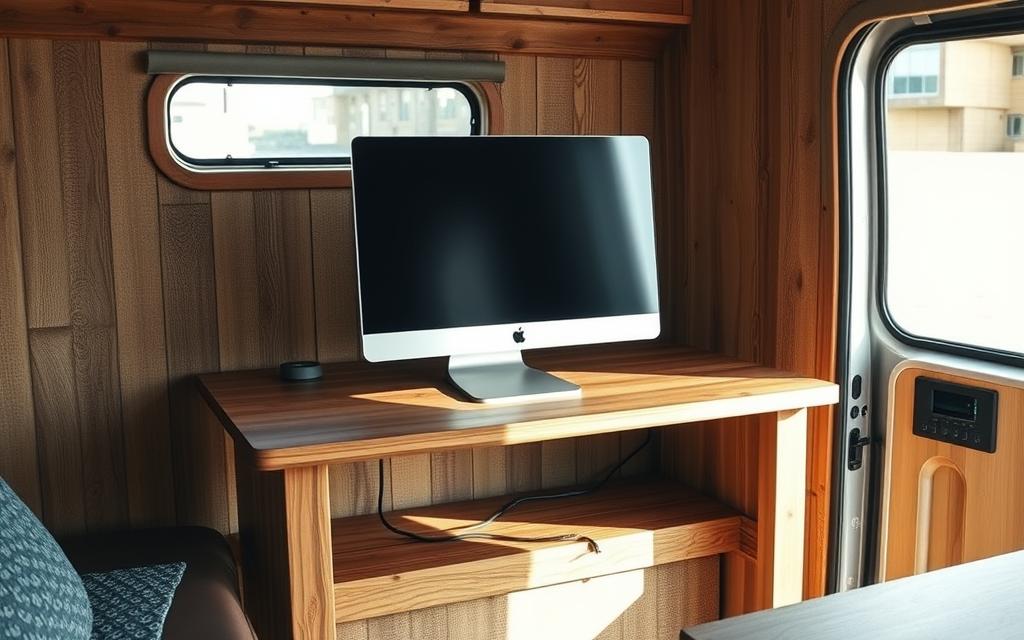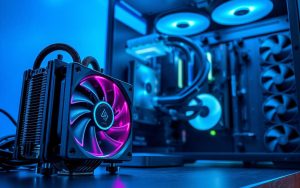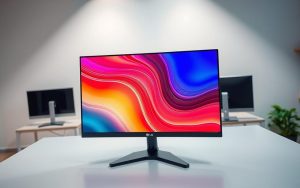Table of Contents
Many travelers wonder if a high-performance setup is feasible in a mobile living space. While possible, running a powerful system in an RV or trailer requires careful planning. Power consumption, limited space, and heat management are key hurdles to overcome.
Energy efficiency is critical when relying on batteries or solar panels. Standard setups may drain resources quickly, but alternatives like compact builds or low-power components help. Proper cooling solutions also prevent overheating in tight quarters.
Balancing performance with practicality ensures a smooth experience. With smart adjustments, even demanding tasks become manageable on the road. The right setup keeps productivity high without sacrificing mobility.
Introduction: Can You Run a Desktop Computer in Your Camper?
Modern travelers increasingly seek powerful computing solutions for life on the road. Traditional RVs faced limitations, but today’s tech bridges the gap between performance and portability.
Over the years, energy-efficient components have transformed mobile setups. Compact GPUs, low-wattage CPUs, and solid-state drives now deliver desktop power without excessive drain.
Forums reveal real-world success stories. One user swapped a laptop for a mini-ITX build, gaining 40% faster rendering while staying within 300W. Others optimize with solar panels or lithium batteries.
Remote work hinges on reliable tools. Whether editing videos or coding, the right setup adapts to any location. A quick search shows thousands now embrace this hybrid lifestyle.
Upcoming sections dive into power needs, cooling, and space-saving gear. Practical solutions await for every tech-savvy adventurer.
Understanding Power Requirements for a Desktop PC in a Camper
Efficient energy use separates functional setups from frustrating failures on the road. Without proper planning, even robust systems falter when resources dwindle. Power management ensures reliability whether parked or moving.
How Much Power Does a Desktop PC Consume?
Standard builds range from 300W to 800W under load. Energy-efficient components like low-wattage CPUs or SSDs reduce draw significantly. Always check manufacturer specs for exact figures.
Example setups:
- Mini-ITX rig: 150-250W
- Gaming PC: 500W+ (requires generator backup)
Calculating Your Camper’s Power Capacity
Lead acid batteries need full recharge cycles to last. Follow these steps to match your system to available power:
- Multiply battery Ah by voltage (e.g., 100Ah × 12V = 1,200Wh).
- Subtract 50% for safe discharge depth (600Wh usable).
- Divide by daily usage hours (600Wh ÷ 8h = 75W max sustained draw).
Roof size limits solar panel arrays. Most campers fit 300-400W panels, generating ~1.5kWh on sunny days. Pair with generators for cloudy stretches.
Problem-solving tip: Track usage with a wattmeter. One traveler ran a 24-hour cycle using solar by day and batteries at night, plus brief generator boosts.
Power Solutions: Keeping Your Desktop PC Running
Reliable power sources make or break mobile computing setups in compact living spaces. Three approaches dominate among full-time travelers: battery banks, solar arrays, and backup generators. Each method suits different location requirements and usage patterns.
Lead Acid Batteries: Charging and Maintenance
Traditional deep-cycle batteries remain popular for their affordability. The Powermax PM4 Series 2 charger cuts recharge times by delivering 80% capacity in half the normal duration. Follow these maintenance rules:
- Check water levels monthly
- Equalize charges every 3 months
- Store at 50% charge when unused

Solar Power: Maximizing Daylight Usage
Photovoltaic panels excel in sunny locations with 5+ peak hours. A 400W system typically generates 2kWh daily—enough for basic workloads. Angle adjustments boost output by 25% compared to flat installations.
Generators as a Backup Power Source
Portable units provide peace of mind during cloudy stretches. Consider these reasons when choosing:
“Propane models run quieter but produce less wattage than diesel alternatives. Parallel configurations double output for demanding setups.”
Always check campground noise regulations before purchasing. Maintenance schedules vary by fuel type—gasoline requires more frequent care than dual-fuel options.
Efficient Desktop PCs for Campers
Energy-conscious travelers optimize performance without draining limited resources. The right components minimize power draw while handling demanding tasks. Strategic upgrades ensure reliability across days of off-grid use.
Low-Power Desktop Options
Intel’s i5 processors use 30% less energy than i7 chips for similar tasks. Compact builds with mini-ITX motherboards save space and watts. Consider these swaps:
- SSDs over HDDs: 2–3W vs. 6–7W during operation
- Integrated graphics for non-gaming tasks
- Undervolting CPUs to reduce heat and power
Performance vs. Power Consumption
High-end GPUs demand a lot of energy but aren’t always necessary. A laptop-grade GPU in a small form factor PC often suffices for video editing or coding. Prioritize components based on workload:
| Component | Power Draw (Idle) | Power Draw (Load) |
|---|---|---|
| RTX 3060 GPU | 15W | 170W |
| Ryzen 5 CPU | 35W | 65W |
| SATA SSD | 0.5W | 3W |
| 2.5″ HDD | 1W | 7W |
“Undervolting cuts 10–15% power use without noticeable speed loss. Pair with efficient cooling to avoid thermal throttling.”
Passive cooling systems eliminate fan energy drain. For intensive tasks, schedule work during peak solar days to leverage renewable energy.
Alternative Computing Options for Campers
Tech-savvy nomads explore diverse computing setups for life on wheels. While desktops offer power, portable devices like laptops and tablets provide unmatched flexibility. Choosing the right tool depends on workflow needs and location constraints.

Laptops vs. Desktops: Pros and Cons
Laptops excel in portability with built-in batteries and compact designs. However, desktops deliver superior performance for intensive tasks like video editing. Consider these trade-offs:
| Feature | Laptop | Desktop |
|---|---|---|
| Portability | High | Low |
| Upgradeability | Limited | High |
| Power Draw | 30–100W | 150–800W |
| Screen Size | 13–17″ | Customizable |
Pro tip: Hybrid setups pair a lightweight laptop for travel with a docked monitor at camp. This balances mobility and ergonomics.
Tablets: The Ultimate Portable Solution?
Devices like the Samsung Galaxy Tab S6 Lite gain popularity among full-time RVers. Their portability and cellular data compatibility simplify work in remote locations. Yet, limitations exist:
- External keyboards improve typing but add bulk.
- Cloud storage eases file access but requires reliable internet.
- Professional software (e.g., CAD tools) may lack full functionality.
“Tablets handle 80% of my tasks—email, light editing, and video calls. For heavy lifting, I remote into a home server.”
Before committing, search for apps that match your workflow. Utilize free trials to test compatibility.
Setting Up Your Workspace in a Camper
Optimizing workspace efficiency transforms cramped quarters into productive mobile offices. Every inch counts when designing a functional area inside a trailer. Prioritize ergonomics and adaptability to maintain comfort during long work sessions.

Choosing the Right Monitor for Limited Space
Compact screens solve the problem of bulky displays. Ultra-thin bezels maximize viewing area without sacrificing portability. Consider these features:
- Vibration-dampening mounts prevent shaking on rough roads.
- Adjustable stands tilt or swivel to reduce neck strain.
- Energy-efficient LED panels draw less power than traditional models.
Foldable designs like the ASUS ZenScreen fit neatly into storage compartments. Pair with a quick-disconnect base for easy stowing when moving.
Securing Your Equipment While on the Move
Bolted stands and Kensington locks deter theft in shared campgrounds. For added safety:
- Use cable ties to organize wires and prevent tangling.
- Install hidden compartments under seating for valuables.
- Check insurance policies cover gear stored in a moving vehicle.
“Laptop anchors with steel cables kept my setup intact during a cross-country trip.”
Test stability by simulating bumps before hitting the road. Secure heavy items at the back of cabinets to minimize shifting.
Cooling and Ventilation for Your Desktop PC
Heat buildup can cripple even the most powerful mobile setups. Tight quarters amplify thermal challenges, demanding smart solutions to protect components. Proper airflow and insulation balance performance with durability.

Managing Heat in a Confined Space
Small spaces trap warmth, raising internal temperatures fast. Strategic fan placement pushes hot air out while drawing cooler air in. Consider these tactics:
- Diagonal airflow paths maximize circulation in square footage.
- Window vents with adjustable louvers direct exhaust outside.
- Thermal pads on SSDs reduce heat transfer to nearby parts.
Humidity worsens heat effects. Silica gel packs inside the case absorb moisture in damp locations. Check them three times monthly during rainy seasons.
Ventilation Tips to Prevent Overheating
Passive cooling works when power is scarce. Copper heat sinks dissipate warmth without fans. For active systems, prioritize:
| Method | Pros | Cons |
|---|---|---|
| 120mm PWM Fans | Adjustable speed; quiet | Uses 5–10W |
| Vent Cutouts | Zero energy; permanent | Requires drilling |
| Liquid Cooling | Efficient for GPUs | Complex installation |
“Mesh side panels dropped my CPU temps by 12°F in Arizona summers. Just dust filters weekly.”
Emergency protocols matter. Auto-shutdown software triggers at critical temps, preventing damage during unattended heat spikes. Test settings before relying on them.
Internet Connectivity on the Road
Staying connected while traveling requires smart solutions for consistent internet access. Whether working remotely or streaming entertainment, stable connections transform mobile living. Modern technologies offer multiple pathways to reliable online access.
Best Options for Reliable Internet
Cellular data remains the most versatile choice for nomads. LTE/5G hotspots provide coverage across 90% of populated areas. For extended stays, consider:
- Unlimited data plans from major carriers (avoid throttling)
- Dual-SIM routers for automatic network switching
- Pay-as-you-go options for international travel
Campground WiFi often suffers from congestion. Forums suggest logging in during off-peak hours for better speeds. Always verify security certificates before accessing sensitive data.
Boosting Wi-Fi Signals Remotely
TP-Link’s outdoor antennas demonstrate how technology bridges connection gaps. Their 2-mile range units outperform standard equipment. Key considerations when enhancing signals:
- Directional antennas focus power toward distant towers
- Omnidirectional models cover 360° for moving vehicles
- Weatherproof housing protects against elements
“Signal boosters increased my download speeds by 300% in national park dead zones.”
Bandwidth management tools help prioritize work traffic. Data-saving extensions like search filters reduce unnecessary consumption. VPNs add essential security layers on public networks.
Maintenance and Longevity of Your Setup
Sustainable power solutions require regular attention and smart habits. Mobile computing systems face unique wear from vibration, temperature swings, and frequent use. Proactive care prevents failures when you’re miles from repair shops.
Regular Checks and Upkeep
Monthly inspections catch small issues before they escalate. For lead acid batteries, desulfation techniques restore lost capacity. Load testing every 90 days reveals weakening cells.
Temperature-controlled compartments protect sensitive electronics. Keep storage areas between 50-80°F for optimal performance. Add silica gel packs to combat humidity in coastal locations.
Extending the Life of Your Batteries and Equipment
Lithium batteries outperform traditional options with three times the cycle life. Follow these storage practices during off-peak months:
| Battery Type | Storage Voltage | Recharge Frequency |
|---|---|---|
| Lithium | 30-50% | Every 6 months |
| Lead Acid | 100% | Monthly |
“My Battle Born batteries lasted seven years with proper maintenance—far longer than the cheaper lead acid ones I started with.”
When adding a new member to your setup, check compatibility with existing systems. Recycling programs properly dispose of old gear, keeping toxic things out of landfills.
Conclusion: Is a Desktop PC Practical for Your Camper?
Lithium battery advancements now make high-power setups more viable for travelers. Reasons to choose a desktop include superior performance for video editing or gaming. However, limited solar capacity or frequent moves may favor a laptop instead.
Over three years, efficient mini-ITX builds often cost less than premium laptops. Lithium batteries last longer in a trailer, offsetting higher upfront prices. Professionals needing rendering power benefit most from desktops.
Before committing, verify power access and workspace dimensions. Prioritize energy-saving components and cooling solutions. With careful planning, desktop rigs unlock unmatched productivity on the road.
FAQ
What power sources work best for running a desktop PC in a camper?
Solar panels, deep-cycle batteries, and generators are the top choices. Solar provides clean energy, while batteries store power for nighttime use. Generators act as a reliable backup.
How can I reduce power consumption when using a desktop in my trailer?
Opt for energy-efficient PCs like mini-ITX builds or low-wattage processors. Also, adjust power settings and avoid running multiple monitors unnecessarily.
Are laptops a better option than desktops for mobile living?
Laptops use less power and take up minimal space, making them ideal for campers. However, desktops offer superior performance for demanding tasks.
What cooling solutions prevent overheating in a confined camper?
Use ventilation fans, position the PC near an open window, or install external cooling pads. Avoid blocking airflow around the tower.
How do I get reliable internet while traveling in my RV?
Mobile hotspots, signal boosters, and satellite internet provide connectivity. Research coverage maps for the best carrier in your location.
Can a standard desktop PC handle movement while driving?
Secure the tower with anti-vibration mounts or foam padding. SSDs are safer than HDDs since they have no moving parts.
What’s the ideal monitor setup for a small camper workspace?
Ultrawide monitors or foldable screens save space. Mounting arms help adjust positioning without taking up desk room.
How often should I check my power system when using a desktop?
Inspect battery levels, solar connections, and inverter performance weekly. Regular maintenance ensures stable power for your setup.









